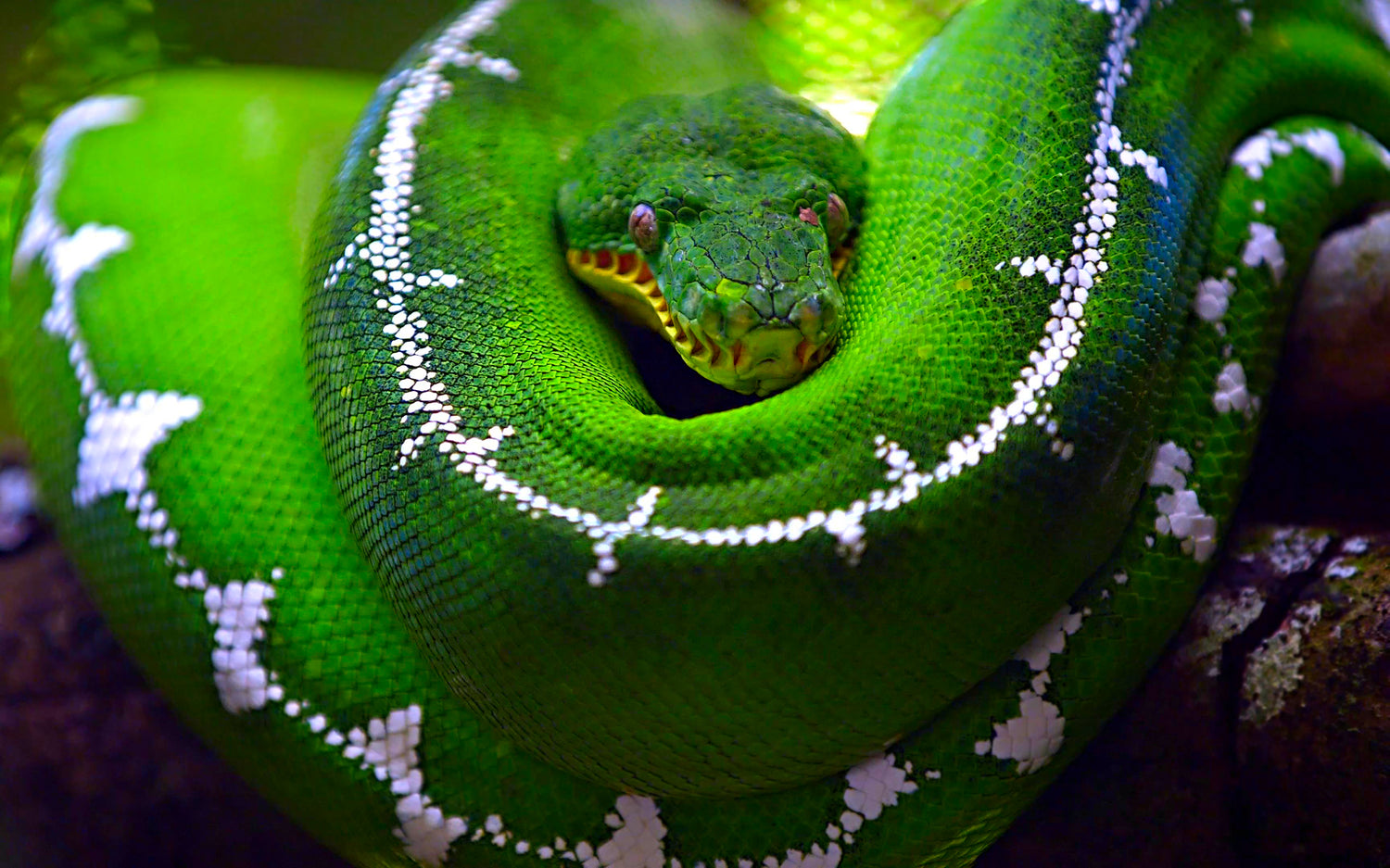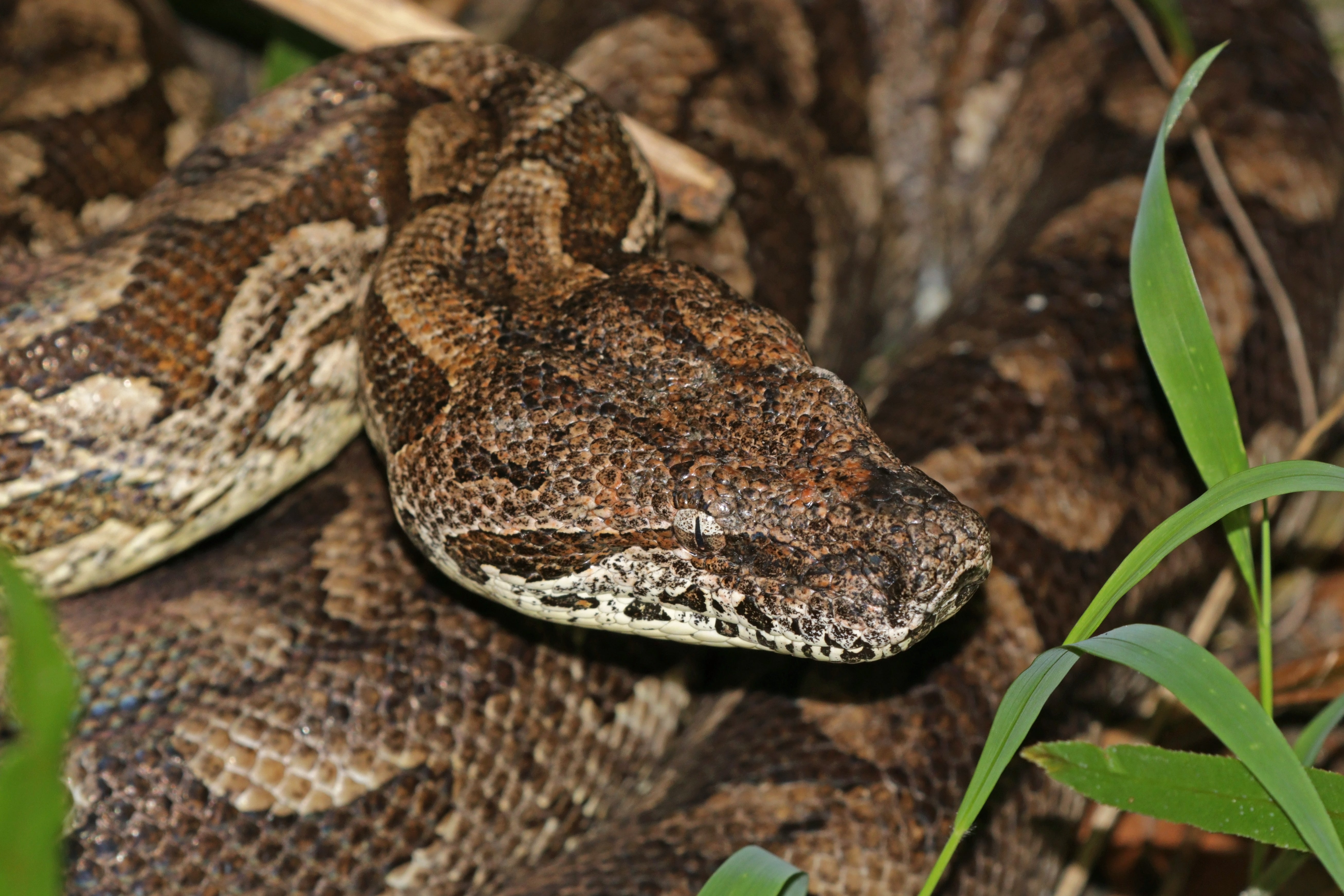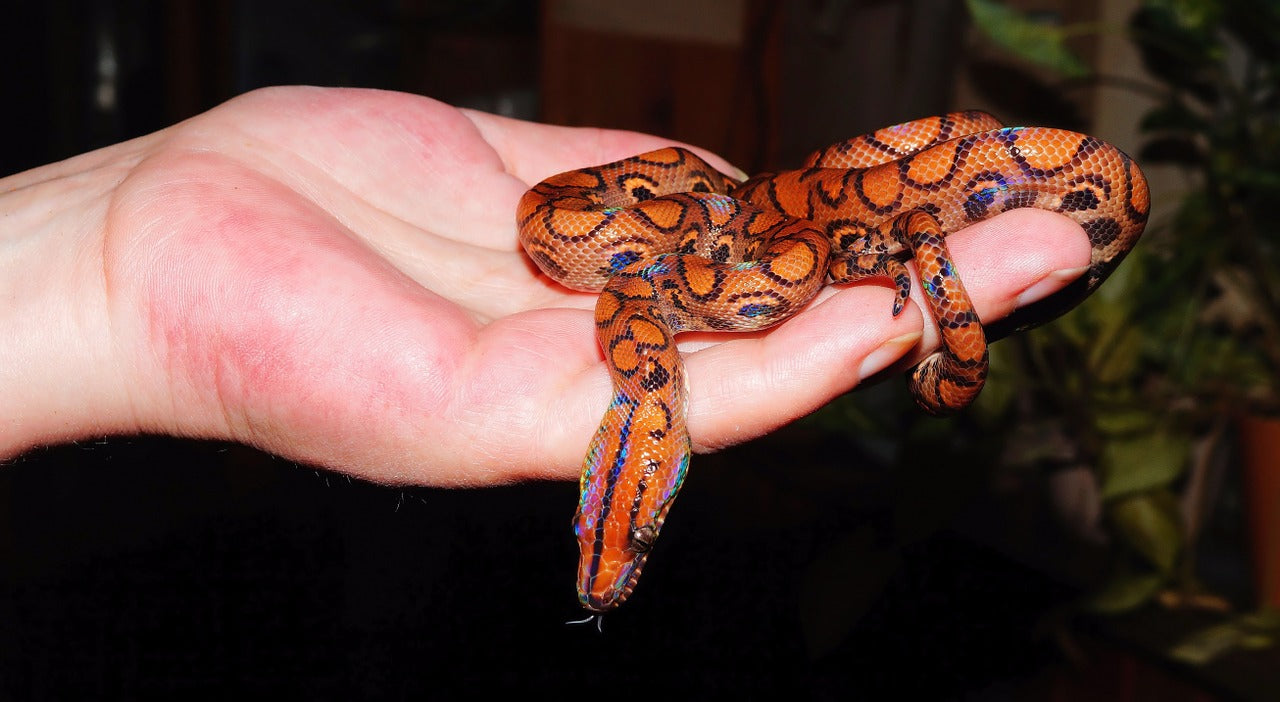Emerald tree boas (Corallus caninus) are medium to large arboreal snakes native to the Guyana and Amazon Basin areas of South America. They prefer lowland tropical rainforests for habitat, spending most of their time in the trees, with occasional trips down to the forest floor.
There are two types of emerald tree boa. The Guyana/Surinam type has a green body with a white belly and white markings, and generally grows to 4-6’ long. The Amazon Basin type has a dark green body with a yellow belly and white markings, and can grow as large as 9’ long. Both types have slender, muscular bodies and blocky heads with almost bulbous snouts and distinctive heat pits.
Emerald tree boas are known for their large, doglike set of teeth, which gives them something of a fearsome reputation. While Guyana/Surinam type emerald tree boas are reported to have a more defensive and unpredictable temperament, emerald tree boas in general can still make terrific display animals and can be a great pet for the right owner. With good care, they can live 20 years or more.
How much space do emerald tree boas need?
Because emerald tree boas are frequently seen hanging out on a single perch, it’s easy to assume that they are sedentary and don’t need much space despite their size. However, emerald tree boas are known to have territories of roughly 2.7 square kilometers per individual, which implies that they are much more active than commonly thought.
The minimum size enclosure for an emerald tree boa must be large enough for the snake to stretch out fully, climb, and thermoregulate. The minimum for appropriately keeping one adult emerald tree boa is 48”L x 24”W x 48”H. This is just the minimum, so using larger dimensions is beneficial and will happily be used!
Cohabitation (keeping multiple emerald tree boas in one enclosure) is not recommended, as this species prefers to be solitary.
Do emerald tree boas need UVB?
They seem to be able to survive without it, but it’s still best practice to provide UVB lighting for optimal health and wellbeing. Emerald tree boas are active during both the day and night, which means that it’s very likely they actively bask in sunlight during the day. Providing UVB lighting to your snake gives them all of the vitamin D that their body needs, stimulates better appetite and activity, and generally allows them to be healthier than they would be without.
The best UVB bulbs for emerald tree boas housed in a 48” x 24” x 48” enclosure are:
- Zoo Med Reptisun T5 HO 5.0, 34”
- Arcadia Forest 6%, 34”
The UVB bulb should be housed in a reflective fixture like the Arcadia ProT5 or Vivarium Electronics, and placed close to the heat lamp, about 11-13” above the basking branch if over mesh, and 14-16” above the basking branch if not. UVB is blocked by glass and plastic, so you can’t give your snake UVB by placing its terrarium in front of an open window. Also make sure that the fixture your UVB bulb is in does not have a clear plastic bulb cover. UVB bulbs decay over time, so don’t forget to replace your bulb every 12 months to maintain good performance.
Lights should be on for 12 hours/day.
What basking temperatures do emerald tree boas need?
Like other reptiles, emerald tree boas are ectotherms, which means that they need a temperature gradient in their enclosure to help them regulate their metabolism and stay healthy.
Emerald tree boas need a basking air temperature between 88-93°F. Ambient temperatures should be maintained around 84°F. Measure air temperatures in these locations with a digital probe thermometer, with the probe placed in the desired area.
Because emerald tree boas are arboreal, heat mats don’t work for heating them. Instead, provide heat for your snake by imitating the sun with a cluster of at least two halogen flood heat lamps placed on one side of the enclosure, positioned over a sturdy basking branch. Do not use colored bulbs, as these are not as effective.
Nighttime temps should be maintained around 78°F. To create these temperatures, you will need a lightless heat source connected to a thermostat, such as a radiant heat panel or cluster of ceramic heat emitters.
What humidity levels do emerald tree boas need?
Emerald tree boas dehydrate easily, and need an average humidity of 70-80%, as measured by a digital probe hygrometer placed in the middle of the enclosure. It’s helpful to install a humid hide for your snake in the upper portions of the terrarium, lined with moistened sphagnum moss. Always having a humid retreat is essential.
Misting your snake’s enclosure with a sprayer first thing in the morning and again at night will help create the right humidity levels. If you need more, installing an automatic misting system and/or cool mist humidifier connected to a hygrostat can be helpful.
What substrate is good for emerald tree boas?
Emerald tree boas require a thick layer of moisture-retentive substrate to help maintain healthy humidity levels. As an added perk, it also tends to make the enclosure more attractive.
Ideally, this substrate should resemble what emerald tree boas naturally live on in the wild: soil. It should have small particles and hold moisture well. We recommend the following substrates for emerald tree boas:
Layering clean, chemical-free leaf litter on top of the substrate can also help with humidity. Substrate should be at least 4” deep and completely replaced every 3-4 months. Remove poop and urates immediately, along with contaminated substrate.
During quarantine, it can be helpful to use puppy training pads to maintain humidity while also making the enclosure easy to clean.
What décor can you use in an emerald tree boa terrarium?
It’s terribly boring for a snake to be stuck in an enclosure with nothing in it except substrate, a branch, and a water bowl. It doesn’t matter how big the enclosure is if you don’t put things in it for your pet to use and interact with.
Since emerald tree boas are arboreal, branches are a VERY important thing to include in their enclosure! These branches should be about as thick as the thickest part of the snake’s body, and the basking perch should be easily removable so the snake can be removed from the enclosure as needed.
Additional décor options include:
- thick vines
- cork tubes
- ledges
- live or artificial plants
Whatever you choose to use, make sure that the snake has cover to hide in so it can feel secure in its environment.
What do emerald tree boas eat?
Like other snakes, emerald tree boas are carnivores, which means that they need to eat whole animal prey in order to get the nutrition that they need. Here is a basic feeding schedule based on snake size:
- Newborns should be fed once every 10 days.
- Juveniles should be fed once every 2-3 weeks.
- Adults should be fed once every 3-4 weeks.
Prey items should be around 10% of your snake’s weight and/or no more than its width. Appropriate prey options include mice, rats, hamsters, gerbils, quail, and chicks. Although live prey can be used, it’s safest and most humane to use frozen instead. Prey should be thawed in a plastic bag in warm water to approximately 100°F before offering with a pair of soft-tipped tweezers.
Supplements
Snakes can survive without vitamin or mineral supplements, but occasionally using them can help prevent nutritional deficiencies and optimize your pet’s health. We recommend Repashy Calcium Plus LoD.
Water
Excellent hydration is critical to the health of an emerald tree boa, so a bowl of water should always be available. Keep the water in this tub clean at all times, and scrub with animal-safe disinfectant once a week.
Do emerald tree boas like to be handled?
Few reptiles actually “like” to be held, and emerald tree boas are not one of them! They are happiest when allowed to be a display animal rather than being handled on a regular basis. To help prevent unnecessary strikes, use a snake hook or paper towel roll to nudge the snake out of the way when you need to enter the enclosure, and wearing a pair of welding gloves isn’t a bad precaution.
*This care sheet contains only very basic information. Although it’s a good introduction, please do further research with high-quality sources to obtain additional information on caring for this species.




Leave a comment
This site is protected by hCaptcha and the hCaptcha Privacy Policy and Terms of Service apply.